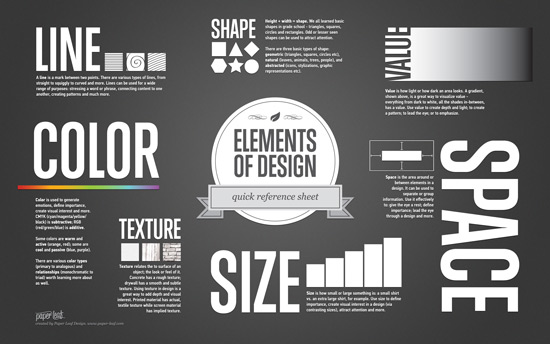Elements of design
- Colour (hue) : a mixture of 3 colours (red, yellow, blue). Colour has few properties including value ( degree of lightness), intensity ( the strength and purity of the colour) and hue (quality that separate one colour from another)
- Line : linear mark that describe a shape by being the edge of an area or surface, colour, tone or pattern, which form an outline.
- Texture : the degree of smoothness or roughness of objects, either tactile or visual surface quality of a shape.
- Size : the relationship of the area occupied by one shape to that of another.
- Value : the tone ( lightness or darkness of the colour)
- Shape : self contained defined area of geometric form.
Balance : control the elements in attracting attention, the feelings of visual equality of elements of design
Gradation: gradation of the colour and size. From warm to cool, dark to light. Gradation can cause our eyes to move along a shape and therefore create movement
Harmony: the combine of similar and related elements that is comfortable for our visual
Contrast: the display of two opposing elements (opposite colours on the colour wheel) or two opposing in tone or value (light/dark) that stands out because they are visually differentUnity: visual linking of elements of the art work and relate the design elements to the idea needed to be expressed
Repetition: shape that are similar to one another, can be in a form of repetition with variation as shown in the picture below
Photo credits to:
http://www.johnlovett.com/test.htm
http://www.paper-leaf.com/blog/2011/02/elements-of-design-quick-reference-sheet/

No comments:
Post a Comment